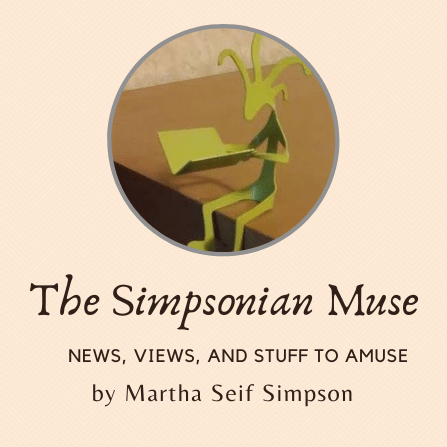May 2025 Issue #50

Happy May!
Welcome to issue #50 of The Simpsonian Muse. I am your scribe, Martha Seif Simpson, Author and Children's Librarian.
This newsletter is different from the previous ones because I was just informed by the Authors Guild, who hosts my website, that they will no longer be supporting newsletters. That means I'll have to find another place to start a new newsletter (and possibly website) which may take time. Therefore, I'm going to skip the Views and Stuff to Amuse sections, and stick to just News, since I don't know if I'll be posting next month.
In March, I had the opportunity to meet with other Jewish KidLit authors at the Jewish Book Council in New York. Here we are: Simona Zaretsky, Isadora Kianovsky, and Arielle Landau from JBC. And authors Martha Seif Simpson, Carole Daman, Linda Marshall, Richard Ho, Josh Levy, Marilyn Wolpin, Liza Wiemer, Chana Stiefel, Ann Koffsky. and Melissa Stoller.

It was great meeting people I had only known online, and greeting others I had met previously at conferences. There's a few STBA winners and honorees in this group!
The book birthday for A Ring For a King: A Tale of King Solomon was April 1st.
Vivian Kirkfield's interview with me about my new book was posted on her blog, Picture Books Help Kids Soar.
The book's illustrator, D. Yael Berhard, announced our book on her Image of the Week Substack.
The book was also on Pinterest.
I'm going to be busy during the next few months, going to book-related conferences and events.
A Ring For a King will be for sale at the Westville Artwalk on May 10 in New Haven, CT. The festival runs from 11 am to 4 pm, and I'll be at the Connecticut Book Festivals booth from 1:30-4 pm. The Artwalk is a fun event, so if you live nearby, come on down!
Later that Month, I'll be at the New England Society of Children's Book Writers and Illustrators conference in Stamford, CT, where I'll attend several presentations and network with other writers and editors.
In June, I'll be attending the virtual conference of the Association of Jewish Libraries, finishing up my duties as advisor to the Sydney Taylor Book Award committee. Later this year, I'll be starting a term as a judge for the Sydney Taylor Manuscript committee, which is for unpublished writers of a Jewish middle grade or young adult book.
Guess what? I won an award!
I won the Ruth Gordon Gadfly Award from the Retired Members Roundtable at the American Library Association, which means they will pay my way to go to the ALA Annual conference June 27-30! (Literally, the day after the AJL conference ends!) The RMRT have the announcement on their website, along with a short biography.
On August 10, I plan on having a booth at the Shoreline Jewish Festival in Guilford, CT. As with the past 4 years, I'll be giving away books I received while serving on the STBA committee, as well as selling my own books.
As you can see, I'm keeping busy in my retirement! In addition to all of the above, I'm working on revisions for a new picture book that I can't announce yet because the publisher hasn't done an official press release. Hopefully, that will happen soon.
Meanwhile, if you can help me get the word out about A Ring For a King, I'd appreciate it. Ask your local library to purchase the book. If you read it, please post a review on Amazon and Goodreads. Every bit helps!
Once I figure out where to restart my newsletter, I'll let you know where to find me. Until then, enjoy the warm weather and remember to enthuse your muse!
![]()
~ Martha